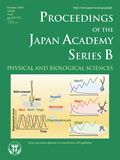About the Cover
Vol. 96 No. 8 (2020)
During mammalian neural development, neural stem cells (NSCs) markedly proliferate, giving rise to neurons, oligodendrocytes, and astrocytes. The basic helix-loop-helix (bHLH) transcription factors Ascl1, Olig2, and Hes1 regulate the specification of neurons, oligodendrocytes, and astrocytes, respectively. However, these factors also play an important role in the maintenance and proliferation of NSCs. Thus, each bHLH factor has opposing functions, i.e., maintaining NSCs and promoting the differentiation of specific cell types, but it was unknown how these factors regulate their opposing functions. Kageyama’s group (this issue, pp. 351-363) developed a live imaging system of these transcription factors and found that Ascl1, Olig2, and Hes1 are expressed in a continuous manner in differentiating neurons, oligodendrocytes, and astrocytes, respectively, but in an oscillatory manner in proliferating NSCs, raising the possibility that these bHLH factors exhibit opposing functions, depending on their expression patterns (continuous or oscillatory). Kageyama’s group previously showed that Hes1, a transcriptional repressor, can repress its own expression by binding directly to its own promoter (negative feedback), leading to its down-regulation. However, when Hes1 expression disappears, negative feedback is cancelled, allowing the next round of expression. In this way, Hes1 autonomously exhibits oscillatory expression, and Hes1 oscillations periodically repress Ascl1 and Olig2 in NSCs, thereby driving their oscillatory expression. By contrast, in differentiating cells, one of the bHLH factors becomes dominant while the others are repressed. To test the hypothesis that different expression dynamics are responsible for the opposing functions of these bHLH factors, Kageyama’s group next developed an optogenetic method, which can induce oscillatory or continuous expression in NSCs by changing light illumination patterns, and showed that Ascl1 induces neuronal differentiation when its expression is continuous, but activates NSC proliferation when its expression is oscillatory. These results suggested that cell fate determination factors such as Ascl1, Olig2, and Hes1 exhibit opposing functions depending on their expression dynamics. These data also indicate that the multipotency of NSCs results from oscillatory expression of multiple fate determination factors, which antagonize each other’s actions. Further understanding of the significance of gene expression dynamics will be useful for the manipulation of NSCs and the development of regenerative medicine in the future.
Shigetada Nakanishi
Member of the Japan Academy




